|
|
|
|
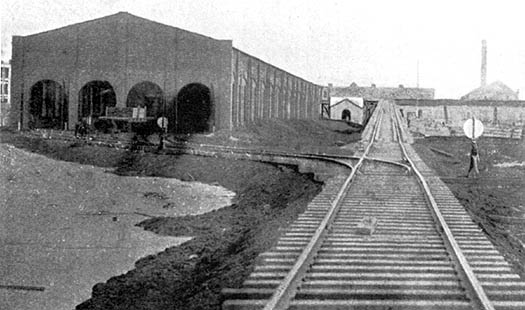 The Hamlin Shop was still under construction when this photograph was taken in March 1896. The Lake Street Elevated and the ramp connecting it to the Hamlin Yard can be seen in the background. (Photo from Street Railway Review) |
|
|
|
|
 The Hamlin Shop was still under construction when this photograph was taken in March 1896. The Lake Street Elevated and the ramp connecting it to the Hamlin Yard can be seen in the background. (Photo from Street Railway Review) |
Hamlin Yard &
Shops
Avers Avenue and Lake
Street, West Garfield Park
Service Notes:
Located:
Lake Street Division
Quick Facts:
Address: TBD
Established: 1895
Shop Area: unknown
Yard Area: unknown
Other Names: Springfield Shops, Avers Shops
Rebuilt: n/a
Status: Yard/shop demolished, now part of West Shops
When the Lake Street Elevated began operations in 1893, they were missing one important component: a car storage yard and repair shop. These facilities were included in the contract for the line's construction, but a suitable location was apparently unavailable. A temporary shop was built at Rockwell Avenue, where the structure widened to four tracks and the outer two each contained a one-track shop barely long enough to fit five of the line's steam locomotives. Limited work room and machine space was provided in an adjacent building, which also housed the company's offices. Cars were stored on a mile-long center track west of Rockwell (which eventually was extended to Pulaski Road); cars were stored there on and off for more than seven decades. Still, this situation was far from ideal and better facilities were desperately needed.
The Hamlin Shops and the accompanying yard were build concurrently with the Lake Street's conversion from steam power to electric traction. Hamlin Shops itself was actually constructed by the West Chicago Street Railroad around 1895 and leased to the Lake Street Elevated. It was also known variously as the Avers Shop, Springfield Shop (both after other nearby streets), and simply as 'the carhouse'.
Hamlin Shops was a four-track facility which was directly along Lake Street but whose entrance actually faced in the opposite direction of the "L". The repair building was a long brick building with a peaked roof, its only exterior decoration an arcade of arches built into the brickwork along the side. The shop fronted on a very small yard, which was connected to the elevated structure by a wooden ramp which had a steep grade of 2.75%. Access to the yard tracks actually required multiple-unit trains to enter the shop building to clear the switch.
As late as 1922, the Hamlin Yard was a very compact place. The west property line was immediately adjacent to the track that fed the ramp that led to the elevated Lake Street tracks. The east property line was immediately adjacent to the east elevation of the shop building. (The north line was at the C&NW tracks and the south was at Lake Street.) There were only six tracks in the yard (not counting the one that led to Lake Street and a small stub that came off it). Though the shop had only four tracks, each could handle at least five cars. Immediately adjacent to the Hamlin Yard on the west was a CSL yard, part of their West Shops complex.
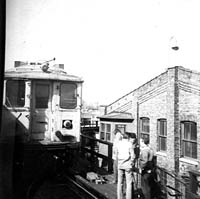 Work car S-357 -- originally car 4429, converted to work motor service in 12/65 -- is on the siding leading into Hamlin Yard. The shop buildings is on the right. View is from passing Lake-Dan Ryan car 2263 at 11:10am, March 14,1973. For a larger view, click here. (Photo by R. Hill, from the Ken Josephson Collection, provided Courtesy of Dave's Train Pictures) |
When the west end of the Lake Street Line was being elevated in the early 1960s, construction also began on a new yard and maintenance facility at Harlem in Forest Park. The 'yard' at Harlem was initially just a few tracks continuing west of the Harlem/Lake terminal, but expansion of Harlem Yard to the point where it was storing the bulk of the cars assigned to Lake Street was pretty much complete by December of 1963. On December 6, 1964 the majority of the Lake Street's cars began to be stored at Harlem, thus ending the need to store cars on the Lake Street center track and taking most cars out of the Hamlin Yard. Construction of the shop and further expansion of the yard at Harlem took a little longer.
On December 6, 1965, the hours of manned operation at the Hamlin Tower, which controlled movements in and out of the yard, were reduced from Monday-Friday all day to rush hours only, signifying the reduction in importance and use of the old yard. In March of 1966, the Harlem shop building was under construction and its completion would mark the beginning of a period of dormancy for the Hamlin Shops. On July 5, 1966, the use of Hamlin Yard for overnight lay-ups was eliminated and all car storage was formally moved to Harlem. On July 3, 1967, almost one year later to the day, the Hamlin Yard was officially closed.
Springfield Shops (as Hamlin Shops was by then often referred to) was reopened in the Spring of 1973 to do cab signal installations on rapid transit cars in anticipation of activating the cab signal system on the North-South Route, as well as the Ravenswood, Evanston, and Skokie lines.
All evidence seems to indicate that after the cab signal work was completed, Springfield (Hamlin) Shops went dormant again. It may have been demolished circa 1976-77. By the late 1970s, the shop was apparently gone. On July 7, 1987 (just over twenty years to the day that the yard closed), the incline leading to Hamlin Yard was removed from service for demolition. This also severed West Shops from the rapid transit system, although it had stopped handling "L" stock over three decades before.
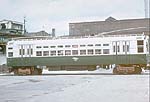 |
cta44.jpg
(105k) |
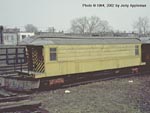 |
ctaS-318.jpg
(50k) |
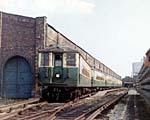 |
cta4000s@HamlinYard.jpg
(164k) |
|
|